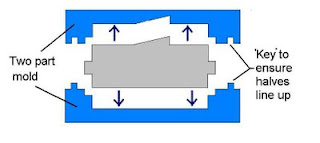Once you have your mold, it’s pretty straightforward to start pouring some resin into it to make your castings.
Check your room has ventilation, use rubber gloves and put some paper or old magazine pages (finally, a use for the Model Railroader!) down under the mold as you'll inevitably dribble a few drops of this araldite-like substance. I also recommend covering the floor if you care about it, in case you have a spillage incident. You will
not get this stuff out of carpet...
Use the right resin. You have a choice between fast cure and slow cure resins. I have a quick resin that sets in about 10 minutes which is great for making lots of simple castings in a short timeframe, for example, I find it OK for containers. However I've surprised myself by becoming a fan of the slower overnight resins for most of my stuff. They are
much stronger, making them perfect for for thin container wagons and for more complex castings. But their real benefit, is that you can take your time as they have a longer 'pot time' (mixing time). The fast cure resin just doesn't give me enough working time to ensure that mold corners are filled and air bubbles are exorcised from complex details before it starts setting.
[NZ content as required by the Commerce Commission: I can recommend the Procast resin from Topmark. its a slow cure resin but sets very hard. I had previously been using easycast which runs like water, but doesn't set hard enough, sets very fast and can deform over time leading to droopy wagons]
Mix WELL. If you don’t do this, you may end up with nasty, sticky, uncured resin seeping out of your otherwise perfect casting forever, even after ou paint it. This is a real heartbreaker and will probably consign that item to the rubbish bin. Mix WELL! I use disposable plastic cups and spoons, and get 3-4 pours from each before they get totally encrusted in layers of resin. Did I mention MIX WELL!
BUT - avoid mixing in air bubbles!
Ensure your rubber mold is sitting flat (yes I have accidentally had a lump of plastic sitting under a PK mold and made a bent wagon) and has any support it might need. The mold in the picture below had a too-small mold box and needs to be supported in the wooden frame behind it to prevent the production of overweight KPs and containers.
 Scrunching the mold while half full of resin. Then it will be relocated into the wooden support behind for the final pour. Position of little fingers optional.
Scrunching the mold while half full of resin. Then it will be relocated into the wooden support behind for the final pour. Position of little fingers optional.After pouring the mould about half-way, I usually scrunch, flex and stretch the mold rubber walls (above pic) to ensure that the resin flows into all the details. I also use a toothpick or stick of plastic to get resin into the corners and pop any visible air bubbles. Then I pour in the rest and use the bubble popper again.
For my flat container wagons, I apply the slow-cure, strong resin with the handle of a disposable mixing spoon a few drops at a time. This lets the resin flow naturally into all the crevices without trapping air. I add shotgun pellets and folded lead (from dental x-rays) to add weight to my container flat castings.
 Making a UK one drop at a time. You can just see the dark shotgun pellets in the poured resin. The dental x-ray lead (foreground right and sets of folded sheets to the left) are about to go in as well. This is how they really made UKs at Hillside.
Making a UK one drop at a time. You can just see the dark shotgun pellets in the poured resin. The dental x-ray lead (foreground right and sets of folded sheets to the left) are about to go in as well. This is how they really made UKs at Hillside. I often place a flat rubber surface (another mold) on top after most of the air bubbles have come to the surface for popping to get a nice flat top to the casting. This saves a dusty mess of sanding off any excess resin later on.

Using another mold (stuffed with containers!) to provide a flat surface on top of the container wagon casting
Wait till the resin has cured per the instructions and then carefully pinch the rubber to break any vacuums and free the casting.
 Peeling Out - note the 'flash'
Peeling Out - note the 'flash'If you placed flat rubber on top, you may have some flash spewage (as in the above pic) that can be cleaned up with scissors and a knife. Do this sooner rather than later because after the prescribed demolding time, the resin will normally continue to harden – the slow cure stuff will do so for up to 2 days, so set aside the casting on a flat surface, or it could bend before it hardens completely.
 All done!
All done!And here are some results. It may not be clear in the pic below but the painted UK has a few air bubbles on top - most of these will be hidden by containers, but I have filled the ones that would be visible that the paint didn't. The KP is a good example of a careful, steady pour with very few imperfections to be fixed (or ignored!). The GSX containers show a quick straight pour (at left), and a slow careful pour with scrunching of the mold (in the centre). Note the considerable difference in the rendering of the side rodding detail. This only comes out well when you get the resin into all the nooks and crannies by scrunching.


















































